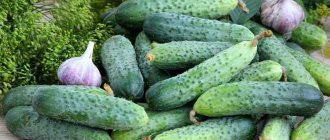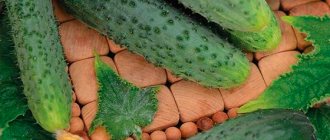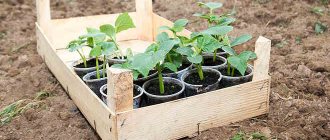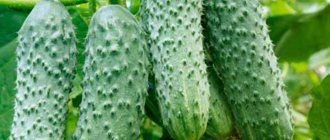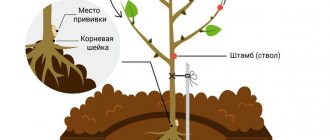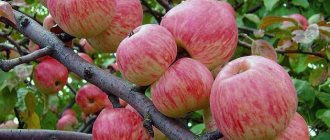Cucumber Shosha F1 – description, reviews, photos
Recently, a new cucumber, Shosha F1, has appeared on the market (in 2016) - description, reviews, photos, planting and care of which are little known, but there is still information, so let’s get to know it.
Description of cucumber variety Shosha F1
Shosha F1 is a parthenocarpic hybrid that does not require pollination, as it is self-pollinating with a female type of flowering. The hybrid is early, the harvest can be harvested 38-40 days after emergence. As a rule, from one to three fruits are tied in a knot.
The hybrid has proven itself well when grown in the North-West of the country, but grows well in other regions.
The cucumber fruits themselves are small, medium lumpy, pleasant green in color with slight white pubescence. The producer of cucumber seeds, Shosha, the Partner company, informs that the yield is 12-18 kg per square meter of planting.
Pros and cons of the variety
If we take into account that there are an average of 3-4 plants per 1 m², it turns out that one cucumber bush brings about 4-5 kg of greens .
Shosha cucumber f1 - in the photo
The fruits are small in size, 9-10 cm long, 3-3.5 cm in diameter, the weight of one fruit varies from 40 to 80 grams. Harvesting can also be done at the gherkin stage.
pros
- The hybrid exhibits resistance to some diseases, in particular, to cucumber mosaic, powdery mildew, and yellow vein virus;
- High yield - up to 18 kg per m² in greenhouses;
- Resistant to short-term frosts and droughts;
- Stores well - up to 10 days without significant wilting or spoilage.
Minuses
- High cost of seed material. The variety is new and a pack for 50-80 rubles can easily contain 5 seeds.
- Added to this is another drawback: the self-pollinating parthenocarpic variety does not ripen completely and does not form seeds. You will not be able to collect material for growing.
Shosha cucumber grows abundantly on the bush.
You can buy Shosha F1 cucumber seeds in any online store, the price is relatively high, approximately 50-80 rubles per package, in which 5-10 seeds are packed.
History of selection
The Shosha F1 cucumber variety is an achievement of domestic breeders.
Its breeding was carried out by specialists from the agricultural company Partner. In particular, Vasily Ivanovich Blockalin, he is recognized as the originator. The State Register of Varieties contains a complete description of the Shosha F1 hybrid. According to the state register, the hybrid is suitable for cultivation in various climatic zones of Russia, in open and protected ground.
Cucumber Shosha F1 - planting and care
Above, a description, reviews, and photos about the Shosha F1 cucumber were presented, and planting and care is a point that all summer residents and gardeners should pay attention to in order to obtain maximum productivity from the parthenocarpic hybrid.
Growing seedlings
To obtain an early harvest, planting is carried out using seedlings, but it is also possible to plant seeds directly into the ground. Sowing seeds for seedlings is carried out no earlier than mid-April; sowing in open ground is carried out in May-June;
Direct planting in the ground
The key to successful planting will be a bed with good soil, fertilized with organic matter. It is also worth remembering that the temperature when planting in the ground should not be less than +16 ﹾC, otherwise the plants will develop poorly or stop growing altogether;
Hybrid planting scheme - 3 plants are planted per 1 m² ;
Advantages and disadvantages
The Shosha hybrid has almost no disadvantages. The only downside is the fairly high cost of the seeds. But this drawback is more than offset by the high yield and high taste of the fruit.
Among the advantages, the following are particularly noteworthy:
- High quality greens. Shoshi fruits are thin-skinned, without bitterness, with tender juicy pulp.
- Excellent yield. If agricultural techniques are followed, the plant is literally strewn with bunches of cucumbers.
- Versatility of use. The variety is suitable for cultivation in open and closed ground.
- High resistance to major diseases of cucumbers.
Care
Forming and tying bushes
The hybrid is tall, with a long main stem (1.5-2 m) and short side shoots, therefore, install a support or trellis in the greenhouse - tie it up so that the cucumbers have room to grow;
Formation
To form a parthenocarpic hybrid, you need to do this: remove all the leaves, flowers and side shoots that form in the lower 3-5 leaves, then remove only the shoots growing from the axils and leave only the ovaries, thus forming the cucumber into one stem.
Hilling
At the beginning of the formation of the bush, it is necessary to hill up the root part of the plant, thereby facilitating the access of oxygen to the roots and protecting them from cold snaps at night. At the very beginning of growth, raise the ground level no higher than half the height of the stem, and when it is already formed, you can hill up to a third of the height.
Further, during the growth process, it is recommended to loosen the soil so that water does not stand on the surface and the roots do not rot.
Watering
Watering should be sufficient, but not excessive, it is necessary to monitor the level of soil moisture so that the plants produce their harvest together and do not lag in development due to a lack of moisture.
Excess moisture not only leads to the development of diseases, but also inhibits vegetative processes inside plants, as a result - poor absorption of nutrients occurs, a kind of “imbalance” occurs, productivity begins to fall, flowers fall off, leaves wither, etc.
Feeding bushes
To obtain a bountiful harvest, it is necessary to apply fertilizer once every 1.5 weeks. One of the well-known natural methods of preparing a solution is a mixture of cow manure and ash. The mixture should ferment well. Instead of ash, you can add superphosphate, but this must be done with extreme caution, the plant grows just as quickly as it accumulates nitrates.
Weeding
Weed cucumbers as weeds appear, too often this is not necessary, once a week
cucumber Shosha f1 hybrid
Shosha cucumber f1 photo of cucumbers on a bush
Diseases and pests
| Root rot Prevention: water only with clean water, loosen the soil around the stems, but do not hill them. Fight: make a paste from wood ash and water and coat the stems to a height of 15 cm from the ground |
| Aphid Prevention: weeding and removing weeds from the site, since it is from them that aphids most often get onto cucumbers. Fight: prepare a solution from a bucket of water, a tablespoon of grated soap and a glass of ash. Leave for a day, strain and spray the cucumbers |
Parasites
However, if the fate of a parasite attack could not be avoided, the type can be determined by the characteristic damage:
- The leaves wither, you find small brown eggs below, this is a NEMATODE . The problem is solved by treating with an abamectin-based agent - Fitoverm, Akarin or similar drugs.
- The leaves are rolled into a bunch or tube around the flower. The cause may be a beige butterfly - LEAF ROLLER . The pest usually attacks in the spring; it is urgent to collect all damaged leaves and treat them with a fungicide.
Reviews
Reviews about growing this hybrid can be published in the comments to the article. After verification, they will be published on the website.
I grew Shosha for the first time. Seduced by the outstanding description and characteristics. The variety developed well even in open ground conditions. The cucumbers are small, crispy, sweet. When marinated they are simply wonderful. I'll definitely plant it next year.
Alexandra, 47 years old
I saw Shosha’s photos on a gardening forum. At first I mistook them for another advertisement. But after reading reviews on the Internet, I decided to try it. At first, Shosha developed as an ordinary self-pollinating cucumber. But after the start of fruiting, it became clear that the yield indicators would be significantly higher. I also liked the taste of the fruit, the thin skin, the juicy tender pulp and the complete absence of bitterness.
The Shosha variety was recommended by a friend. It was not possible to find seeds in stores, so I had to order them online. When sown in open ground, the plants developed well. After all other varieties began to dry out from powdery mildew, Shosha continued to bear fruit. The yield of the variety was truly impressive.
My neighbor highly praised Shosha, which is simply the best in terms of yield and taste. And I’m so-so. The skin is thick, they outgrow and become oak. Maybe it’s a matter of agricultural technology, but I won’t experiment anymore.
Irina L. Ekaterinburg
A good variety, I grew it on the balcony in pots with a diameter of 10 cm. I germinated it first in peat tablets, then directly into the pot in them. The cucumbers are delicious, not bitter at all, and there are a lot of greens. I immediately placed a support, they climbed perfectly.
Shosha always helps out, I’ve been growing them for several years, the harvest gives back together, I collect a bucket and pickle them. I grow it in a polycarbonate greenhouse, under the wall, with a lot of light. Excellent cucumbers.
Irina, N. Novgorod
I grow shosha in a greenhouse. Germination is good, I soaked it in toilet paper, all 5 seeds sprouted. Early hybrid. The yield is good; sometimes there are small voids in the cucumbers. The cucumber tastes sweet, there are a lot of ovaries and cucumbers.
There is no vegetable grower who would not try to choose a variety that is more suitable for himself among the numerous cucumber novelties. Looking through the fresh hybrids offered by breeders, looking for ideal options, without a doubt, gardeners fix their gaze on the crop with the affectionate name Shosha.
Agro guarantees incredible results that the hybrid will delight its consumers with.
Shoshi Recipes
Pickling cucumbers
Housewives are also interested in the question: is the Shosha F1 cucumber suitable for pickling? Yes, it is perfect for preparing for the winter, salting, pickling and pickling, as well as fresh consumption - according to the manufacturer. According to reviews, this hybrid grows well both in open ground and in greenhouses and does not require much effort to grow.
Delicious recipe for pickling with lemon and vodka
To prepare delicious crispy cucumbers for the winter without sterilization, take 1 kg of freshly picked fruits, rinse well, prepare 1 tbsp. rock salt and sugar, 1 tsp. citric acid, ¼ cup of vodka and 1000 ml purified drinking water.
Place cucumbers in jars (the tails do not need to be cut off), add dill, horseradish and currant leaves to taste, garlic and other spices and herbs as desired. In its pure form with just garlic and dill it turns out even tastier, but that’s up to anyone.
Boil water, pour boiling water into jars and let stand for 15-20 minutes, then pour back into the pan and bring to a boil again. Now add salt, sugar, lemon to the pan, let it dissolve, pour in the vodka and immediately pour boiling brine over the cucumbers and roll up. Delicious, crispy, simply delicious, try it too!
The greens with the cheerful name Shosha F1 cucumber - description, reviews, photos, planting and care are now well known to you, and if you take proper care and good care, you are guaranteed an early harvest!
Characteristics and description of the variety
The Shosha cucumber is one of the most advanced products of Russian selection. Scientists have created a cold-resistant plant with excellent production and taste qualities. This made it possible to cultivate the crop in almost all regions, from the southern zone to the central and northern regions.
In addition, this hybrid is able to grow and develop well in:
- greenhouse conditions;
- indoor environment, on the windowsill;
- open ground.
Reviews
Olga Evgenievna, 45 years old, Pskov region
This year I planted Shosha cucumbers on my summer cottage for the first time. The result exceeded all expectations. The harvest was rich, but it could not be processed quickly. But I was pleased that even after several days of lying, the cucumbers remained fresh and crispy. Separately, it is worth noting the crop’s resistance to diseases and pests. A neighbor who has been growing this variety for a long time advised me to treat the bushes with insecticides against aphids, which I did.
Alevtina Mikhailovna, 42 years old, Tver
Shosha cucumbers are one of my favorite varieties. I plant them directly in the ground with seeds, since there is no way to grow seedlings myself. Almost all the planted seeds germinate every time. I plant in early June, when the weather is warm outside. I harvest a consistently good harvest every season. I mostly salt and pickle cucumbers, so I pick the fruits ahead of time.
Nikolay Valerievich, 50 years old, Leningrad region
I am an avid gardener and love experimenting with different crops. It is quite difficult to find tasty and high-quality vegetables, including cucumbers. On the recommendation of a neighbor, I decided to plant Shosha cucumbers and was right. The fruits ripen dense, crispy, tasty and aromatic. Ideal for fresh salads. An added bonus is their long shelf life in the refrigerator.
Olga Evgenievna, 52 years old, Moscow region
I grow Shosha cucumbers in a greenhouse and outside. I collect greenhouse crops in mid-June. We mostly eat them fresh. But those in open ground begin to ripen in mid-summer. Here they are ideal for pickling - all the same size, as if chosen. All household members like these cucumbers - tasty, crispy and appetizing.
Advantages and disadvantages
Shosha is a newcomer to the seed market. Just a year ago, breeders offered it to farmers. And meanwhile, vegetable growers who managed to try it immediately added it to the list of promising ones, thanks to many advantages:
- Simple agricultural technology;
- High yield;
- Duration of fruiting;
- High shelf life;
- Excellent transportability;
- Disease resistance.
The excellent characteristics of the hybrid are also appreciated by farmers who grow herbs for wholesale sales. The fruits tolerate transportation well and can retain their quality for 2 weeks. These indicators allow us to supply cucumber products to other countries.
Read also: Video recipe for cooking shanks in the oven
Shosha has no particular disadvantages. They stand out only based on individual preferences: taste, juiciness, appearance.
Basically, gardeners consider the rather high prices for seed material of this hybrid to be the biggest disadvantage. You just have to buy it, since collecting it yourself is impossible.
Reviews from gardeners
Although Shosha is a very young, new crop on the market, he has already managed to gain fans.
Many thanks to all the agronomists who gave us the miracle of Shosha cucumbers. Marinated, fresh and salted, they are very tasty. I especially liked the lightly salted ones. The gherkins do not lose their elasticity, they remain strong and crispy. And how pleased the harvest was! It took quite a long time to collect it.
Shosha turned out to be very persistent. They withstood the drought and sudden cold snap with dignity. Not a single disease affected the plantings. This is both personal observation and reviews from our friends.
Pavel Maikov, Surgut:
In my greenhouse, Shosha began to bear fruit first. A lot of ovaries formed, they began to fill quickly. The crop is very hardy, and even in our climate I got a fairly large harvest. The taste is pleasant, I was especially pleased with the characteristic crunch of the greens.
Evgenia Maksimovna, Pskov region:
I collected a significant harvest of cucumbers from Shoshi, but did not have time to process everything - I had to leave urgently. How I worried later that I at least didn’t entrust the cucumbers to my neighbor. I arrived 2 days later, but all the cucumbers in the summer box were fresh, as if they had just been picked.
There were no difficulties in care, even easier than with other hybrids. It is necessary to take preventive measures against aphids. We had a whole wave of it this summer. Many lazy summer residents lost their harvest. And I processed Shosha and reaped a huge harvest.
The characteristics of the hybrid distinguish it as very productive and early ripening. The cultivation technology is simple and quite acceptable to all vegetable growers. Only the lazy will not reap the harvest from Shoshi, and only because they are simply too lazy to collect.
Shosha cucumber is a hybrid variety of domestic selection. Its cultivation was carried out by Agro, which tested the crop in open and protected non-chernozem soil. Therefore, the hybrid is recommended for cultivation in central Russia. According to positive reviews from gardeners, this variety is famous for its tasty fruits and ease of care.
